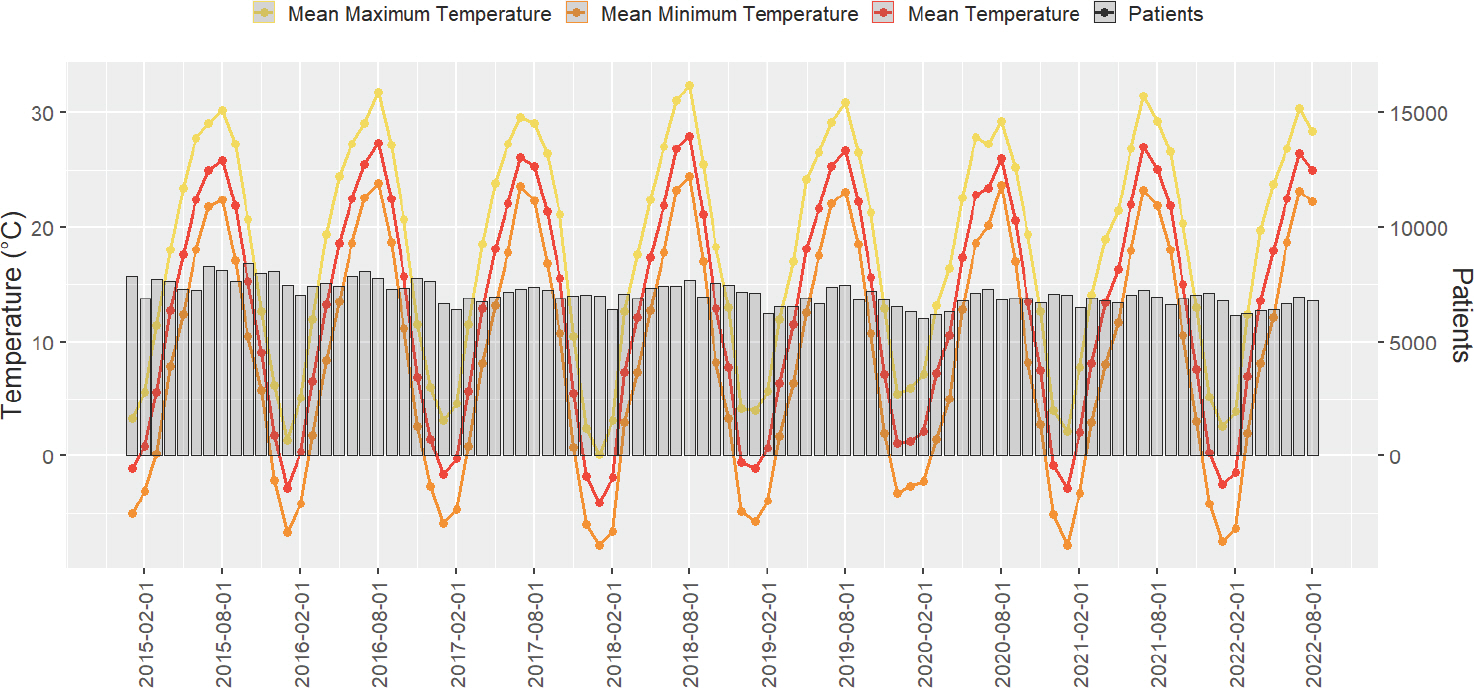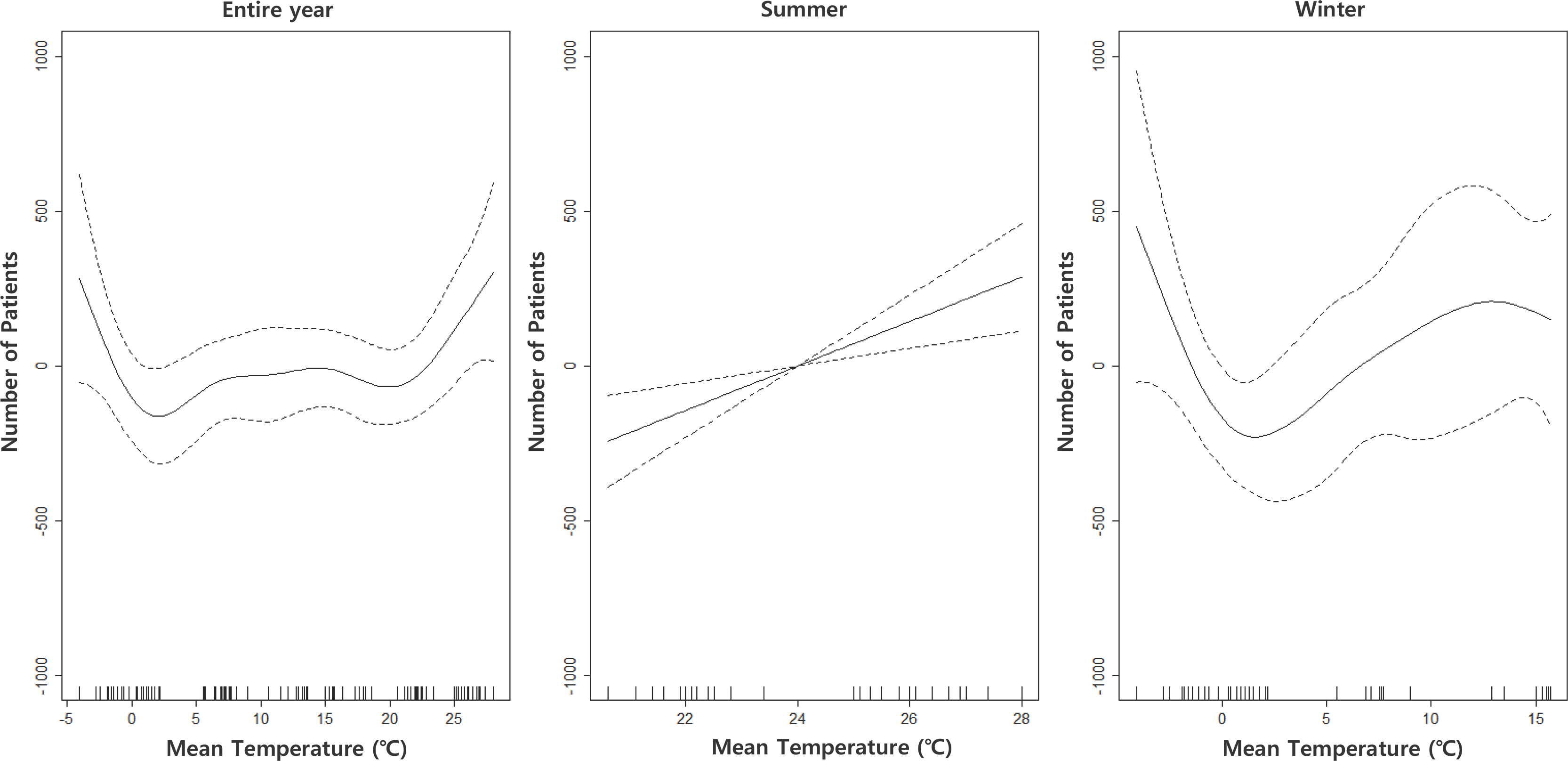J Korean Soc Matern Child Health.
2023 Oct;27(4):231-237. 10.21896/jksmch.2023.27.4.231.
Association between Temperature and Diabetes Mellitus in Pregnancy
- Affiliations
-
- 1Department of Environmental Medicine, College of Medicine, Ewha Womans University, Seoul, Korea
- 2Institute of Ewha-SCL for Environmental Health (IESEH), College of Medicine, Ewha Womans University, Seoul, Korea
- 3Department of Human Systems Medicine, College of Medicine, Seoul National University, Seoul, Korea
- 4Graduate Program in System Health Science and Engineering, Ewha Womans University, Ewha Medical Research Institute, College of Medicine, Seoul, Korea
- KMID: 2547473
- DOI: http://doi.org/10.21896/jksmch.2023.27.4.231
Abstract
- Purpose
Exposure to heat and cold stress can negatively affect pregnant women. However, studies on the association between ambient temperature exposure and pregnant women, especially those with diabetes mellitus, are limited. The presence of this disease is likely to affect the woman’s capacity to adapt to the demands of pregnancy, consequently affecting fetal development. We examined the association between exposure to the mean temperature and diabetes mellitus during pregnancy.
Methods
Health Insurance Reviews and Assessment Service was used to obtain data on patients hospitalized between January 2015 and August 2022. The association between the number of pregnant patients with diabetes mellitus according to monthly mean temperature and seasonal differences was analyzed using a generalized additive model. The model was adjusted for the treatment date, mean humidity, and mean age of the women.
Results
The total number of patients with diabetes mellitus in pregnancy was 651,655 and the mean temperature was 12.87℃±9.89℃. The association between the mean temperature and diabetes mellitus during pregnancy showed a U-shaped nonlinear association. During the entire period, the number of patients with diabetes mellitus in pregnancy significantly increased by 2.82 per 1℃ increase in mean temperature (estimate, 2.82; 95% confidence interval [CI], -2.06 to 7.71). The number of patients significantly increased by 72.12 per 1℃ increase in mean temperature in the summer (estimate, 72.12; 95% CI, 50.36–93.89), but the increase was not statistically significant in the winter.
Conclusion
Our findings suggest that maternal exposure to mean temperature during pregnancy is associated with diabetes mellitus.
Figure
Reference
-
Booth GL., Luo J., Park AL., Feig DS., Moineddin R., Ray JG. Influence of environmental temperature on risk of gestational diabetes. CMAJ. 2017. 189:E682–9.
ArticleChersich MF., Pham MD., Areal A., Haghighi MM., Manyuchi A., Swift CP, et al. Associations between high temperatures in pregnancy and risk of preterm birth, low birth weight, and stillbirths: systematic review and meta-analysis. BMJ. 2020. 371:m3811.
ArticleFaunt JD., Wilkinson TJ., Aplin P., Henschke P., Webb M., Penhall RK. The effete in the heat: heat-related hospital presentations during a ten day heat wave. Aust N Z J Med. 1995. 25:117–21.
ArticleFong A., Serra A., Herrero T., Pan D., Ogunyemi D. Pre-gestational versus gestational diabetes: a population based study on clinical and demographic differences. J Diabetes Complications. 2014. 28:29–34.
ArticleGraham JM Jr. Update on the gestational effects of maternal hyperthermia. Birth Defects Res. 2020. 112:943–52.
ArticleHIRA Bigdata Open Portal. Medical information statistics [Internet]. Wonju (Korea): Health Insurance Review & Assessment Service;2023. [cited 2023 Apr 17]. Available from:. https://opendata.hira.or.kr/op/opc/olap3thDsInfoTab1.do.Huang M., Strickland MJ., Richards M., Holmes HA., Newman AJ., Garn JV, et al. Acute associations between heatwaves and preterm and early-term birth in 50 US metropolitan areas: a matched case-control study. Environ Health. 2021. 20:47.
ArticleKang HS., Hyun MS., Lee HJ. Trends in diabetes mellitus during pregnancy: prevalence and health care utilization. J Korean Soc Matern Child Health. 2010. 14:170–80.
ArticleKim H., Ha JS., Park J. High temperature, heat index, and mortality in 6 major cities in South Korea. Arch Environ Occup Health. 2006. 61:265–70.
ArticleKim KS. The importance of treating mild hyperglycemia in pregnant women with diabetes. Korean J Intern Med. 2018. 33:1079–80.
ArticleKim SW. Management of endocrine disorders during pregnancy. Korean J Intern Med. 1999. 57:750–64.Korea Meteorological Administration. Open MET data portal [Internet]. Daejeon (Korea): Korea Meteorological Administration;2023. [cited 2023 Apr 17]. Available from:. https://data.kma.go.kr/cmmn/main.do;jsessionid=y1KPg7XjwUbiOl7bTp7T2L1452QnN6p1MZnZJFWcBVaXw4vfxj2Dc1aozrAc0GF5.was01_servlet_engine5.Korean Statistical Information Service. Statistical database [Internet]. Daejeon (Korea): Korean Statistical Information Service;2023. [cited 2023 Apr 17]. Available from:. https://kosis.kr/index/index.do.Kwag Y., Kim MH., Ye S., Oh J., Yim G., Kim YJ, et al. The combined effects of fine particulate matter and temperature on preterm birth in Seoul, 2010-2016. Int J Environ Res Public Health. 2021. 18:1463.
ArticleLaine MK., Kautiainen H., Gissler M., Pennanen P., Eriksson JG. Impact of sunshine on the risk of gestational diabetes mellitus in primiparous women. Int J Circumpolar Health. 2020. 79:1703882.
ArticleLuo J., He G., Xu Y., Chen Z., Xu X., Peng J, et al. The relationship between ambient temperature and fasting plasma glucose, temperature-adjusted type 2 diabetes prevalence and control rate: a series of cross-sectional studies in Guangdong Province, China. BMC Public Health. 2021. 21:1534.
ArticleMøller N., Beckwith R., Butler PC., Christensen NJ., Orskov H., Alberti KG. Metabolic and hormonal responses to exogenous hyperthermia in man. Clin Endocrinol (Oxf). 1989. 30:651–60.
ArticleMoses RG., Wong VC., Lambert K., Morris GJ., San Gil F. Seasonal changes in the prevalence of gestational diabetes mellitus. Diabetes Care. 2016. 39:1218–21.
ArticlePart C., le Roux J., Chersich M., Sawry S., Filippi V., Roos N, et al. Ambient temperature during pregnancy and risk of maternal hypertensive disorders: a time-to-event study in Johannesburg, South Africa. Environ Res. 2022. 212(Pt D):113596.
ArticlePrasad M., Lumia M., Erkkola M., Tapanainen H., Kronberg-Kippilä C., Tuokkola J, et al. Diet composition of pregnant Finnish women: changes over time and across seasons. Public Health Nutr. 2010. 13(6A):939–46.
ArticlePreston EV., Eberle C., Brown FM., James-Todd T. Climate factors and gestational diabetes mellitus risk - a systematic review. Environ Health. 2020. 19:112.
ArticleRoos N., Kovats S., Hajat S., Filippi V., Chersich M., Luchters S, et al. Maternal and newborn health risks of climate change: a call for awareness and global action. Acta Obstet Gynecol Scand. 2021. 100:566–70.
ArticleRylander C., Odland JO., Sandanger TM. Climate change and the potential effects on maternal and pregnancy outcomes: an assessment of the most vulnerable the mother, fetus, and newborn child. Glob Health Action. 2013. 6:19538.
ArticleSmith ML., Hardeman RR. Association of summer heat waves and the probability of preterm birth in minnesota: an exploration of the intersection of race and education. Int J Environ Res Public Health. 2020. 17:6391.
ArticleStrand LB., Barnett AG., Tong S. The influence of season and ambient temperature on birth outcomes: a review of the epidemiological literature. Environ Res. 2011. 111:451–62.
ArticleTsujimoto T., Yamamoto-Honda R., Kajio H., Kishimoto M., Noto H., Hachiya R, et al. Seasonal variations of severe hypoglycemia in patients with type 1 diabetes mellitus, type 2 diabetes mellitus, and non-diabetes mellitus: clinical analysis of 578 hypoglycemia cases. Medicine (Baltimore). 2014. 93:e148.Tucker P., Gilliland J. The effect of season and weather on physical activity: a systematic review. Public Health. 2007. 121:909–22.
ArticleWang YY., Li Q., Guo Y., Zhou H., Wang QM., Shen HP, et al. Ambient temperature and the risk of preterm birth: A national birth cohort study in the mainland China. Environ Int. 2020. 142:105851.
ArticleWestphal SA., Childs RD., Seifert KM., Boyle ME., Fowke M., Iniguez P, et al. Managing diabetes in the heat: potential issues and concerns. Endocr Pract. 2010. 16:506–11.
Article



